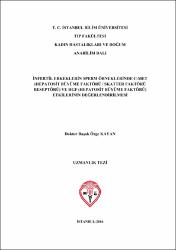İnfertil erkeklerin sperm örneklerinde C-MET (hepatosit büyüme faktörü / skatter faktörü reseptörü) ve HGF (hepatosit büyüme faktörü) etkilerinin değerlendirilmesi
Künye
Kayan BO. (2016). İnfertil erkeklerin sperm örneklerinde C-MET (hepatosit büyüme faktörü / skatter faktörü reseptörü) ve HGF (hepatosit büyüme faktörü) etkilerinin değerlendirilmesi. Yayımlanmamış tıpda uzmanlık tezi. İstanbul : İstanbul Bilim Üniversitesi, Tıp FakültesiÖzet
Hepatosit büyüme faktörü, pek çok organ ve dokuda güçlü mitojenik aktiviteye sahip pleiotropik bir sitokindir. C-met, tirozin kinaz aktivitesi olan bir transmembran glikoproteini olup hepatosit büyüme faktörü reseptörü olarak görev yapar. Bu çalışmada hepatosit büyüme faktörü ve c-met’in sperm motilitesi ve erkek infertilitesi üzerine etkisi araştırıldı.
Çalışma ileriye dönük, kontrollü, tesadüfi olmayan, tek merkezli bir klinik çalışma olarak tasarlandı. Çalışma Mart 2015 ile Haziran 2016 tarihleri arasında gerçekleştirildi. Çalışmada kontrol ve çalışma grubu olmak üzere iki grup mevcuttu. Kontrol grubu çocuk sahibi olan, sağlıklı ve çalışmaya katılmak için gönüllü erkek bireylerden oluştu. Kurumun Invitro Fertilizasyon Birimi’ne müracaat eden ve erkek infertilitesi tanısı alan bireyler ise çalışma grubuna dahil edildi. Çalışmaya dahil olan tüm bireylerden sperm örnekleri alınarak ikiye bölündü. Örneklerden biri taze olarak incelenirken, diğeri donduruldu ve uygun koşullarda saklandı. Taze örneklerde c-met ekspresyon, dondurulan örneklerde hepatosit büyüme faktörü düzeyleri ölçüldü. Birincil sonuç ölçütleri, hepatosit büyüme faktörü ve c-met ekspresyonu değeri, ikincil sonuç ölçütleri ise sperm sayısı, morfolojisi ve motilitesi olarak belirlendi.
Etik kurul onayı ve hasta onamları alınan 18-60 yaş arası toplam 92 birey dahil edildi. Kontrol grubunda 31, çalışma grubunda 61 birey mevcuttu. Hepatosit büyüme faktörü düzeyi, kontrol grubunda; c-met ekspresyon düzeyi, çalışma grubunda daha yüksek saptanmış olup, istatistiksel olarak anlamlı fark izlendi. Tüm olgularda sperm motilite yüzdesi ile c-met ekspresyon düzeyleri arasında pozitif, sperm konsantrasyonu ve sperm morfoloji yüzdesi ile c-met ekspresyon düzeyleri arasında negatif korelasyon izlendi.
Sonuç olarak reseptör c-met ve ligandı hepatosit büyüme faktörü, erkek spermatogenez, sperm motilitesi ve fertilizasyon kapasitesinde temel düzenleyicilerden birisi olarak görünmektedir. Erkek infertilitesi için gerek etiyolojinin belirlenmesi, gerekse patogenezde değerli bir parametredir. Hepatocyte growth factor is a pleiotropic cytokine with potent motogenic capaticies in a variety of tissues and organs. C-met is a transmembrane glycoprotein with tyrosine kinase activity and serves as a hepatocyte growth factor receptor. In the present study, the impact of hepatocyte growth factor and c-met expression on sperm motility was evaluated.
The study was designed as a single-centre, non-randomized prospective controlled clinical study and was conducted between March 2015 and June 2016. There were two groups in the study: the control and the study group. Volunteered healthy men who have already had children were included to the control group, whereas the study group was composed of men who admitted to Invitro Fertilization clinics and who were diagnosed to be infertile. Semen samples were obtained from all individuals who were included to the study. The samples were divided into two parts. One of them was examined as a fresh sample, whereas the other one was frozen and was kept under appropriate conditions. The primary outcome measures were the level of hepatocyte growth factor and c-met expression. The secondary outcome measures were sperm count, sperm motility and morphology.
Following the Ethics Committee approval and informed patient consents, aged 18-60 years 92 men were included to the study. The number of men in the control and the study group was 31 and 61, respectively. The levels of hepatocyte growth factor were found to be statistically greater in the control group and c-met expression were found to be statistically greater in the study group. In all cases there were a positive correlation between sperm motility percentage and c-met expression levels, and negative correlation between sperm concentration, sperm morphology percentage and c-met expression levels.
In conclusion, receptor c-met and its ligand hepatocyte growth factor appear to be on of the main regulators in male spermatogenesis, sperm motility and fertilization capacity. The identification of etiology is also a valuable parameter for male infertility in pathogenesis.


















